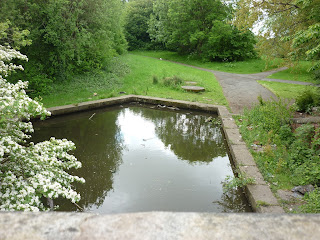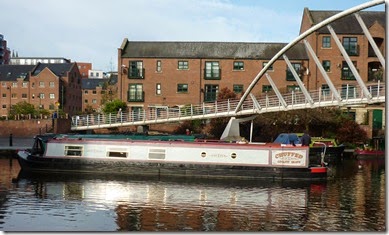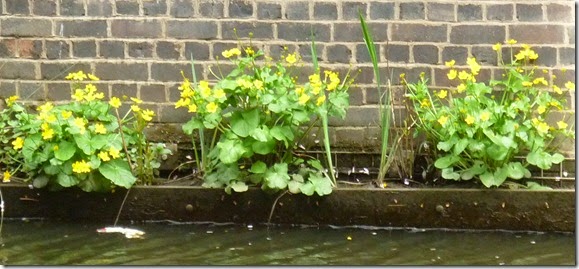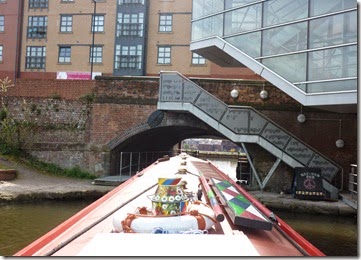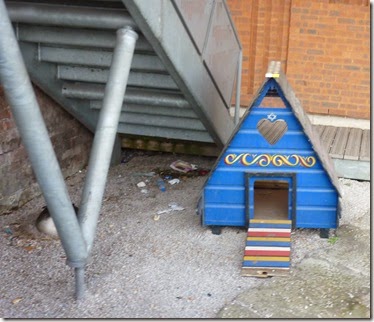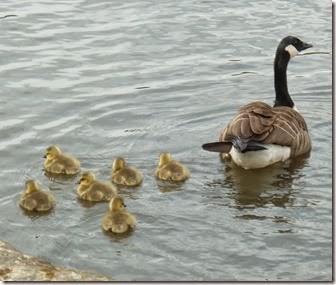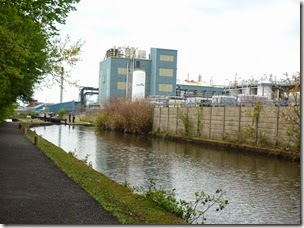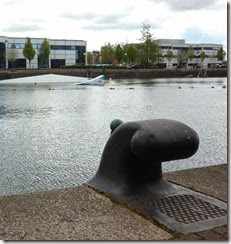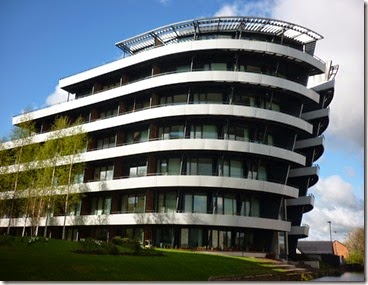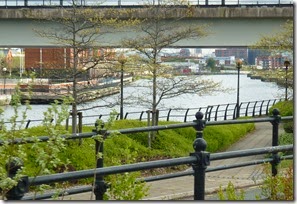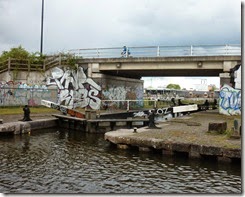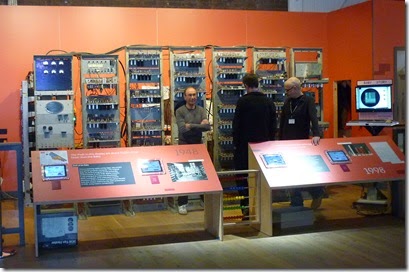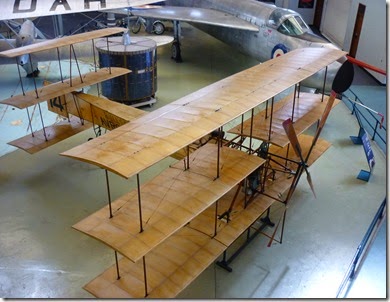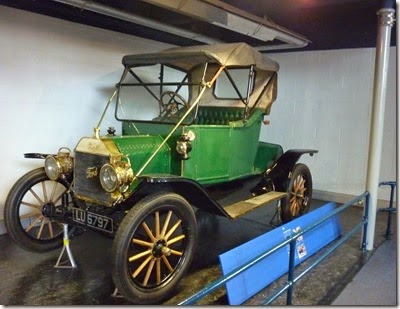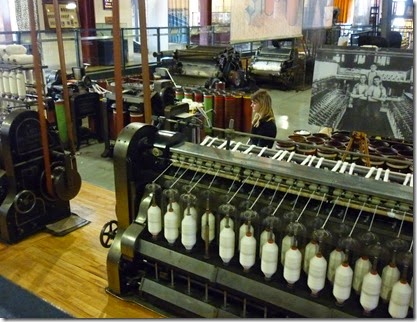Saturday 30 May 2015
By this evening we should have been well on our way to the Standedge Tunnel for passage on Friday, but the best-laid plans …. there is a stoppage the other side of the tunnel. A hole has been discovered in an embankment and the canal is closed between locks 12 and 13E for a couple of weeks. So we’ve done a bit of rescheduling. We have commitments at home later in June so can’t just put everything off for two weeks! So we decided to go up the Rochdale and see how things are when the next CRT update is due at the end of the week and with a bit of luck we’ll be able to complete the South Pennine ring in a clockwise direction instead. Or maybe not.
No pictures today – after a tedious journey up from Devon we unpacked in light rain and just got everything on the boat before it tipped down. Later on we popped over to the convenient Tesco for some supplies and in the hope I could get some clothes … we usually forget something on our trips – thermals once in winter, my phone charger – this time I completely forgot any jumpers apart from the one I was wearing! and shorts, though they may not be needed of course. I thought I could at least get a cheap jumper from Tesco for locking, but no, it’s summer – no jumpers. I did get some shorts though and I’ll see what I can get in Manchester tomorrow.
Thursday 28th May; Droylsden – New Islington
We planned an early start to get down the Ashton locks but not only did we oversleep but the Black Prince which came in last night was up and away before we were anywhere near ready. So we relaxed for a while and I took a couple of snaps of Oscar, one of the resident dogs. He’s extremely energetic and doesn’t keep still for photos, even though he and Meg had been charging up and down just before!
We set off before 9, leaving a forlorn Oscar watching his friend sail away.
We were expecting the locks to be against us, but there was such a strong wind that many of the bottom gates had blown open too, so that was extra work. However, as we are now the proud possessors of a folding bike, courtesy of some friends who have had to give up their boat, lockwheeling was much quicker than it was coming up the Ashton a few weeks ago. As we started down the Clayton flight we were delighted to see a boat coming up – perhaps there would be at least a few locks in our favour now!
It was a single-hander. He had set his alarm for 3.45 this morning and we suspect had just stopped for breakfast as the next lock was empty, whether because the Black Prince had used it or through leakage we don’t know. Anyway, this was the only lock I didn’t have to turn. Below lock 11 is the junction with the Stockport Branch. It looks good from the lock -
but is now a bit shorter than it was.
According to http://www.penninewaterways.co.uk/locks.htm the deepest narrow lock on the system is Vinegar Lock, no 10 on the Clayton flight. Unfortunately the locks are nor named either lockside or in Nicholson’s, so here are some pictures of what I think is Vinegar Lock! I’d forgotten which number to look out for when I took the pix.
On the Beswick flight, opposite the Etihad stadium, the Moscow State Circus was setting up. We went to see them once in Devon when the children were small, around 1990. We would have been impressed with the beautiful black horses ‘dancing’ in synchrony, but we had seen them in their stalls before the show when they just stood there, blank-eyed and still, not like any horses we had seen before or since. They performed with the same lack of expression. It was quite disturbing.
This is the second deepest narrow lock on the system – Harry Garner’s lock on the Beswick flight.
Close by are the tennis courts of Sport City. There were several games going on and Meg was beside herself, running back and forth crying piteously to be let in to play.
At last we reached the Ancoats flight. We were quite tired; Dave had been fighting gusting crosswinds all the way and I had been battling to stay upright on the unfamiliar little bike. In the not very pretty surroundings of Ancoats bottom lock there was this little treasure to cheer me up.
It’s an orchid but I’m not sure which. We turned at Ducie Street junction to rise up two double locks and arrive at New Islington marina shortly before 3, where we squeezed in on the visitor moorings for a late lunch. Then I nipped over to the nearby Go Outdoors and managed to get a couple of fleeces in lieu of the locking jumpers I left at home! We strolled up to Piccadilly Gardens later on for a meal in Zizzi – unfortunately not as good as the one in Paddington.
4 miles 20 locks (18 narrow, 2 broad)
We saw just one boat on the move though two came into New Islington while we were there.
Tuesday 12 May 2015
Better than the gym ….
Friday 1st and Saturday 2nd May
We aimed for an early start because of all the horror stories you hear about the Rochdale and Ashton, but apart from one slightly weird incident it was all absolutely fine.
By 8, Dave had reversed off our berth and was manoeuvring towards the first of the infamous Rochdale 9 Locks.
We weren't exactly full of trepidation but were prepared for a day’s hard work. The challenges were not only physical; my first task, having emptied the lock, was to work out which way to wind the windlass to open the gates, which are operated by chains as there isn’t enough room for full-length beams.
The gates are so heavy that angled lock beams wouldn't work. You see these sometimes on narrow canals, as at Star Lock in Stone, where space is restricted. Luckily for me most of the gates aren’t chain operated - you’d have thought I’d have had no trouble having managed it once, but no, I got muddled at the start of them all. Anyway, up we went!
More delays ensued. On most of the top gates the paddle gear was protected by a cover which could only be opened by unscrewing its lock with the anti-vandal key. This was time-consuming even once I’d got the hang of it. The previous user had done them up pretty tightly, which didn’t help. It took us half an hour to get through the first lock and our hearts were sinking!
But we soon got into the swing of it. As we were going up rather than down it was easy for Dave to get off and help with the top gates, although in the end only one gate, near the top of the Nine, was so heavy I couldn’t do it on my own. We had glimpses of the sun as we travelled the canyon between the high buildings on each side. There were some wonderful Victorian buildings as well as modern offices and flats.
The canal was filthy. I removed a length of bubble wrap but most of the rubbish was small and/or out of reach. We would have been there all day if I’d tried to collect it all. The small bits in the water and caught on the lock were actually cherry blossom petals! we caught a brief glimpse of the tree above one of the bridges. The pink colour hasn’t come out well unfortunately.
In spite of the mess (and so much broken glass that Meg had to remain on board all the time) there were signs that some people do care about the surroundings – below one building were those planting arrangements we’ve sometimes seen in cities and the marsh marigolds (kingcups) were in full bloom.
We had to turn most of the locks; as there is water cascading over most of the top gates they are kept well topped up! In one of them there was an obstruction behind a gate. This is the only advantage of double locks if you don’t have company! As I opened the other gate, I noticed a CRT lorry on the bridge above so it was a simple matter to report the obstruction. They came down with their super-long rake and grappling hook, and could feel the obstruction, but luckily told us to carry on and fill the lock. They caught up with us at Chorlton Street lock. This is on one of the stretches without a continuous towpath, so one of them had to climb over the wall to collect a heap of rubbish they had netted earlier. They hadn’t managed to recover the obstruction, and he said he‘d be going down there with a wetsuit later on …. rather him than me! He also promised to grease the top paddles of that lock which were very stiff. Parts of the canal pass under buildings – these long covered stretches stink of p***, and although the longer ones are lit, they are not pleasant to go through.
Near the top of the Nine, we saw this little duck house, one of several we’ve seen this trip. Pretty, but empty. Behind the bridge support was a Canada goose on her nest. By the time I saw her it was too late to take a better photo. I don’t think she is putting the ducks off – there aren’t any round here.
It took us three and a quarter hours to climb the Rochdale 9, which isn’t bad considering the reputation of the flight. Now for bandit country! As we cruised the lock-free stretch of the Ashton canal before the first of the Ancoats flight, we were accompanied by a young man riding his bike – at 3mph – making no eye contact whatever. I went and locked the front doors. As I filled the first lock (thankfully narrow locks now) he sat leaning on a lamp-post, again not looking at us. I was quite worried and took a photo of him just in case with the camera concealed behind the paddle gear! He cycled off with a wave and a smile so I’ve used the other photo I took! Don’t want to malign the poor chap!
 Dave hadn’t been concerned; he was pretty sure the guy had been taking something recreational and was just very chilled. There would have been lots of witnesses to any incident, as there were plenty of customers in the coffee shop in the background!
Dave hadn’t been concerned; he was pretty sure the guy had been taking something recreational and was just very chilled. There would have been lots of witnesses to any incident, as there were plenty of customers in the coffee shop in the background!
Soon we approached the Chips development of New Islington. It’s supposed to have been inspired by three fat chips on top of one another http://www.e-architect.co.uk/manchester/chips-manchester.
On we went. I’d bought snacks in the little shop under the Castlefield arches and made some rolls, so we had lunch on the move and refuelled as necessary with squash and cake. At the Beswick locks the canal passes through Sport City, the home of the Etihad stadium and the Olympic-standard velodrome of the National Cycling Centre. Harry Garner’s lock on this flight is 13’ 3” deep (1” more than Etruria top lock on the Caldon), and Vinegar lock on the Clayton flight is 13’ 10”, now the deepest narrow lock in Britain http://www.penninewaterways.co.uk/locks.htm.
Along the way we saw two broods of goslings – the second was bigger and more photogenic -
some very ropy steps on the Clayton flight
and a smelly chemical works.
One of the upper locks of the Clayton flight was very leaky. I took this photo before raising the paddles – look at the top of the picture and you can probably predict what happened next!
This!
It didn’t take long to empty the next lock, which released enough water for Dave to get Chuffed over the lock sill, and then I ran more water down so he could creep along the middle of the canal.
 We were soon through the Copperas swing bridge (the one at Yew Tree was already open) and ascended our final two locks at Fairfield. In spite of most of the paddle gear (on both top and bottom gates) having to be unlocked, then relocked (and me having to go back when one or other of us locked the paddle gear with the paddles still up – we both did this twice, doh!) - as we shared the top gate work as we usually do, and I locked ahead when possible, we made it into Droylsden marina just after 4.
We were soon through the Copperas swing bridge (the one at Yew Tree was already open) and ascended our final two locks at Fairfield. In spite of most of the paddle gear (on both top and bottom gates) having to be unlocked, then relocked (and me having to go back when one or other of us locked the paddle gear with the paddles still up – we both did this twice, doh!) - as we shared the top gate work as we usually do, and I locked ahead when possible, we made it into Droylsden marina just after 4.
The lovely Jane, Tom and another moorer whose name I can’t remember soon got us moored and made us very welcome. The two resident dogs, Oscar and Dexter, greeted us enthusiastically and investigated us thoroughly before taking Meg off to run up and down the pontoons. No pictures – I’ll have to take some when we return. Meg didn’t need a walk fortunately, having come along with me on the towpath for most of the Ashton.
Today we travelled 5 miles, with 27 locks (9 broad, 18 narrow), 1 swing bridge, in 8 hours. We didn’t see a single boat on the move today.
Stats for the trip (according to Canal Planner);
| Miles | 74 miles 6 and a half furlongs |
| Locks | 69 narrow, 9 broad, total 78 |
| Swing bridges | 2 (one open) |
| Tunnels | Five. Harecastle (2919 yds), Barnton (572 yds), Saltersford (424 yds), Preston Brook (1239 yds), Deansgate (78 yds according to Nicholson’s, but we didn’t actually notice it!) |
| Hours | somewhere between 36 and 40 |
On Saturday morning, Dave left before 9 to catch a succession of trains and a replacement bus back to Stone to fetch the car, and by the time he returned, having had a tedious journey up the M6, I’d finished cleaning and packing up. We packed the car in intermittent drizzle before the journey home. Meg had been running around with Oscar and readily settled down to sleep. We made it home in four and a half hours.
All being well, we plan to cruise the South Pennine Ring on our next trip.
Monday 11 May 2015
Matchstick Men and help! where are we going to leave the boat?
Thursday 30th April
After heavy overnight rain, and with the morning showery and cold, I got on with some cleaning and a bit of shopping while Dave continued the search for a berth and working out how to get back to Aston to collect the car. Portland Basin were waiting for a call from a boat that’s out at the moment, while Stretford marina has no spaces for the length of time we need. The persistent cold weather seems to be delaying the summer cruising plans of marina residents! We like this mooring though. Amazing bridges all around – the footbridge bounces if enough people are on it!
And we must have the best views of all the berths; bridges to the stern, boats to the front, the Merchants Warehouse on one side and on the other a broad area of paving with grass beyond, from where I took this photo. And apart from the trains and trams it’s quiet!
I took Meg out for a blast along the towpath, snapping the derelict Hulme Lock which I unaccountably failed to notice yesterday, distracted as I was by the graffiti.
We had an early lunch then went under the railway arches to climb the tower to the Metrolink line. (I took the snap on our way out to eat in the evening, hence the lights and the moon!)
The Metro is not especially cheap (no discounts for crumblies) but is fast, frequent and clean, and gave us good views of the Bridgewater and Ship canals into the bargain. In the photo below, the cut to Pomona Lock from the Ship Canal is just visible to the left of the tower block.
We alighted at Salford Quays, not the closest to our destination as it turned out, but we were able to see some of the redeveloped quays on our way to the Lowry gallery. I came here in the early 90s for my leaving do when I was made redundant from ICL. We went to the first big pub/eatery of the redevelopment, which had just opened, and all I remember of the Quays was grey wind-tossed water and utter desolation – not desolated by losing my job though, as I was quite relieved not to have to travel up from Devon any more.
We walked along Ontario Basin, which is huge, and saw the bollards, chains and hooks used by sea-going ships. The bollard below is as big as a stool, and my foot in the other pic gives the scale of the hooks. In the background of the first photo you can see ramps for water-skiing – there is a water sports centre here too.
There is some stunning architecture here, but it was freezing cold in the wind so we didn’t take many snaps. This is the Millennium Bridge (also known as the Lowry Bridge), which you cross to reach the Imperial War Museum. It’s actually a lift bridge because ships which still use the basin. http://manchesterhistory.net/manchester/bridges/lowry.html has better pictures and some technical details.
Our destination was the Lowry gallery, where there is a permanent display of a lot of L S Lowry’s best work which includes ‘traditional’ portraits and drawings, not just the matchstick men pictures! It was fascinating but unfortunately no photography is allowed inside. The building, which also houses a theatre, is not as stunning as some of the others in the area – we’ll have to wait till next time to investigate those as we needed to get back to Meg.
Meg was pleased to see us of course, but even better was when Dave called Sharon at Portland Basin and she said just ‘turn up at Droylsden (where they put temporary moorers) and we’ll fit you in’. Hurray! I walked Meg later on and called on Fred and Lisa on Chyandour, who waved as they passed earlier on their way to the end of the basin. They had spent a few days at Droylsden and assured me that we would be absolutely fine with the lovely people there. Nice to meet you!
We went out for a curry later. Plenty of choice, but we wanted somewhere close that had some customers in it so didn’t choose the one by the basin, which was empty. On our way we passed the little shop under the railway arches which has a brilliant sculpture outside by the bike racks.
We went to the third restaurant we saw, Akbar’s, which was huge and heaving buzzin’ (as I believe the young people say). We had a pager to tell us when our table was ready. We only bothered to wait because we’d seen it recommended in a booklet we picked up at Knott’s last night. Well worth it – it’s as noisy and crowded as your old school dinner hall, but we had an excellent meal, and the waiter was great. Clearly they want you to vacate your table when you have finished but we didn’t feel particularly hassled to leave, although the bill did arrive just a minute after we said we didn’t want any dessert …. The nans are huge – about 20” long – and are served hanging on a vertical support. Meg enjoyed her share which she had for breakfast on Saturday!
A non-cruising day.
Saturday 9 May 2015
A different view of Manchester
Wednesday 29th April
25 years ago both of us worked for ICL (the UK computer company later owned by Fujitsu), and used to come up to Manchester by train or plane from Devon – we both worked from home. So we were familiar with Piccadilly, a couple of hotels, and the taxi ride to the office at West Gorton. This was a tower block in a dismal part of the city, with condemned blocks of flats on the other side of the road amid vandalised shops and desolation, but there were views of the Pennines once you went up a few floors. So we were keen to find out about the modern city and were away before 9 – still cold, still breezy and showery.
Things of interest were the occasional cranes, ready to drop stop planks in case of a breach;
The Linotype works, built in 1897 to manufacture ‘hot metal’ type for printing newspapers;
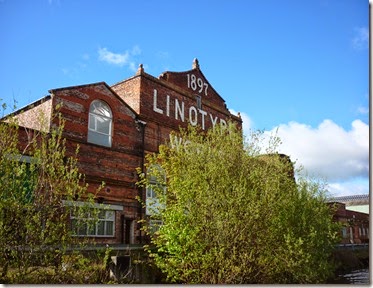 and these amazing ocean liner flats! the closest we’ll get to a transatlantic cruise I think.
and these amazing ocean liner flats! the closest we’ll get to a transatlantic cruise I think.
We did see a kingfisher flash by too but we can’t remember where it was – it may have been yesterday anyway! As we entered the long straight north of Timperley Bridge we could see a double scull in the distance, the rowers resting on their oars. I was hoping for an action shot, but they suddenly shot off into the distance and by the time we caught up with them they were out of the water. On to Waters Meeting – it sounds grand and poetic but we found it rather drab. We passed the Manchester Utd ground (not worth a photo with all its security fencing) and then the much more interesting first view of the Ship Canal and then Pomona Lock.
Soon after 11 we were moored in Castlefield basin opposite the restored Merchants Warehouse, now let as offices though work continues on the ground floor.
We went for an orientation stroll round the basins and had a look at the start of the Rochdale. A hire boat was just starting up on the Cheshire ring – I wonder what time they’ll be finishing tonight? We walked round by the Roman gardens area, where we saw this cutaway section of the foundations of the various iterations of the city wall.
After lunch (the hearty and very welcome soup I made yesterday) we visited the Museum of Science and Industry close by. It occupies five listed buildings and has outside areas too with a platform, rails and station building of the Liverpool and Manchester Railway. An exhibit near the main entrance caught our attention – a replica of ‘Baby’, an experimental computer built in 1948 at Manchester University to prove the concept of digital storage which our modern life now depends on! It weighed 1 tonne and stored a tiny amount of data compared with … I don’t know, a central heating control today? It’s like comparing a narrow-boat with a transatlantic liner! The photo below shows the replica Baby and the three volunteers with whom we had an interesting geeky conversation.
Between this and the main entrance is a replica of an Avro F, the first plane with a completely enclosed cabin. The pilot climbed in through a hatch in the roof. The thing that looks like Meccano in the central window pane is the joystick and he (it probably was a he in 1912) had to sit behind it and stretch his legs along the length of the cockpit
We explored the Textiles gallery and saw a brief demonstration of a loom – more of this later. Then off to the Air and Space gallery across the road in the magnificent Lower Campfield Market Hall, built in 1876. In 1983, after 80 years or so as the City Exhibition Hall, it became a museum.
It contains a fascinating selection of aircraft, cars, motorbikes and bicycles made in and around Manchester. The first exhibit you see is the replica of a triplane built by A V Roe and Company – Avro. I took this photo from the mezzanine floor above.
Just a few pictures from the visit – a Model T Roadster, made by the first Ford factory outside the USA at Trafford Park; a cutaway jet engine; and a kamikaze plane. Like the Avro F just inside the main entrance to the museum, this was unexpectedly small. The railings in front were waist high and the exhibits almost within touching distance.
Then Dave went off to the Power Hall to see the various engines (including a steam locomotive) while I returned to the Textile Hall for the main demonstration. They have examples of the machines which carried out all the steps of cloth production. The cotton bales were roughly broken up then passed through the scutcher, which beat the cotton to knock out seeds and bits of stick. They didn’t demonstrate this – I think it might have broken down, but anyway it produces a lot of dust and fibre in the air. The pad of fibre produced is then carded to align the fibres to produce a roll of cotton which then goes through several stages of spinning - pulling and twisting the fragile fibres together into a strong single thread - to become the yarn which is used to weave cloth.
The spinning machines above were belt driven by electricity, but originally the power would have come from a steam engine. In the original factories, the machines were much closer together than these two and accidents happened – an arm caught in the belt would cause serious injury to an adult, but a child could be whipped up towards the works in the roof and killed.
The spinning machines were noisy but the loom was much worse. The demonstrator showed how the shuttle was threaded then put it into the machine, flicked a lever and stood well back. In real life the operator would have had 6 looms under her control, each needing a new bobbin (and shuttle re-threading) every 6 minutes – so no standing back and watching.
The racket was tremendous, and that was just from one machine. The demonstrator stood well away for the short while it was running. In a weaving shed there could have been a thousand, the air full of dust and fibre and the noise shattering. An exaggerated form of lip-reading, called Mee-maw, was developed to communicate in the weaving sheds, but as your hearing would be permanently damaged within a week, it had to be used outside as well. You had to be careful if you wanted a private conversation!
Life expectancy was poor – if you weren't injured by moving parts you died from lung disease. Loom operators had a life expectancy of 27; when replacing bobbins they had to suck the thread into the shuttle, thus inhaling fibre hundreds of times a day. This meant there was a ready supply of orphans – children as young as five were used to do the jobs in small spaces, such as crawling under machines to remove cotton fibres from the floor – and the machines were not stopped while they did this. Laws were passed to prevent children under 9 from working in factories, but not actually enforced until the Factory Act of 1833. Grim up North? it certainly was if you worked in the mills.
We’ll go back next time we’re in Manchester to see some of the other galleries – it’s brilliant. We’ll spend tomorrow here, then leave Chuffed in a marina for a few weeks. We’re waiting for a phone call from Portland Basin tomorrow.
Dave’s injured foot wasn’t up to strolling up through Deansgate so we had an excellent pint in the nearby Knott Bar, which was still packed with the after-work crowd. We managed to get a seat so ate there too – a delicious pie (Dave) and scrumptious pulled pork burger (me).
9 and a half miles, no locks





